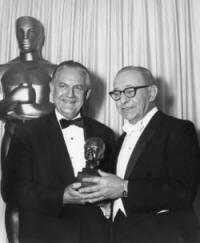Making movies. Enjoying movies. Remembering movies.
THE SCREENING ROOM
Related Articles:
"The Sound
Of Music" 40th Anniversary Tribute
|
A Remembrance By Rick Mitchell
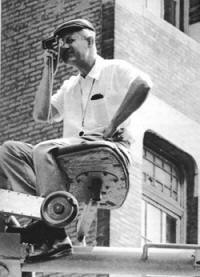
"Directed by Robert Wise"
This was the last of the contractual credits on the inside cover page of
the comic book adaptation of "Helen Of Troy" (1955), and though I'd seen
that credit on all the movies I'd seen previously, this was the first
time it struck me as having some significance. At the time I didn't know
what, but from that moment I did begin to associate the names to which
the credit was ascribed with films I liked.
Later that year I saw "Somebody Up There Likes Me," not the type of film
I normally enjoyed in those days, but back then we went to the movies
every Saturday and Sunday afternoon regardless of what was playing, and
"Somebody Up There Likes Me" was probably the first "adult"-type drama I
enjoyed. And it was "Directed by Robert Wise."
Later, I would see "Run Silent, Run Deep" (1958), "Odds Against
Tomorrow" (1959), "The Day The Earth Stood Still" (1951) on TV, and
ultimately "West Side Story" (1961). By then I not only had some idea of
what a director did, but had even done it in a high school amateurish
way, though I was not yet cognizant of the unique touch that made Bob's
films stand out for me. But I would never have dreamed that I would ever
get to meet and know him personally and actually be privileged to work
on two of his projects: as first assistant editor on "Star Trek: The
Motion Picture" (1979) and as editor of the 1980 version of "The Heart
Of Hollywood," an intra-industry promotional short for the Motion
Picture and Television Fund, new versions of which had been done every
few years (we even included an archival clip from an earlier version).
|
|
|
Robert Wise accepts the Irving G. Thalberg Award from Arthur Freed in 1966 |
Though I officially met Bob in 1971
when I invited him down to USC for a discussion preceding screenings of
"The Set-Up" (1949) and "The Sand Pebbles" (1966) in venerable old
Cinema 108, I'd had occasion to watch him at work the year before. I was
working at Universal when he was shooting "The Andromeda Strain" on
Stage 12 next to the Film Library where I was then employed. Except for
"Star Trek" for obvious reasons, Bob's sets were always open, unless it
was uncomfortable for the actors or something dangerous was being shot,
like the explosion of "The Hindenburg" (1975) (which was scheduled for
the end of the day and everyone working in the vicinity of Stage 12 was
let off, just in case).
Actually, like Alfred Hitchcock, Bob did 50 percent or more of his work
in pre-production, so his on-set work was primarily ironing out
specifics of dialog delivery and bits of business with the actors. He'd
usually do several takes until he got one he liked, then would go for
one more, just in case.
Because of his background as an editor, Bob liked to say that he
protected himself by covering every angle he could think of, which
implies that he shot a lot of film. In fact, on "Star Trek," except for
two days in which they were using multiple cameras, we never had more
than 25-30 minutes of dailies, but everything the editor needed to put
the scene together, along the basic lines Bob intended, was there. Todd
Ramsay, editor of "Star Trek," who had been the assistant on "The
Hindenburg," told me it was the same on that film.
In dailies, Bob would give the editor a rough idea of his take on the
scene, if there was something specific that he'd like to have used,
etc., but generally left the first cut up to the editor. And yet, his
intentions were clear from the coverage: where he began his medium
shots, over-the-shoulders, singles, etc. In dramatic scenes, he
generally preferred to start wide to orient the audience to the
geography, then move increasingly closer as the intensity of the scene
rose. At the same time, he was also very much aware of the effectiveness
of going wide at the peak of a dramatic scene. And, of course, as a
former editor, he was aware of how a film starts to take on a life of
its own once the first cut has been made and tried to anticipate the
needed material to accommodate what might arise out of this.
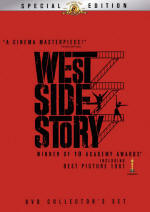 |
As an editor, the most important thing
I learned from Bob, albeit indirectly, was the importance of "two
frames." Although no one seems to care about doing so today, I've always
been obsessed with making perfectly timed cuts, even when working on my
own stuff in 16mm, and in those days, had been frequently frustrated at
cuts that I could never get to feel right. (I had been promoted to
editor at Universal before dropping back to assistant because of the
opportunity to do "Star Trek.") One day, Todd pointed out that all of
Bob's suggested trims amounted to two frames or multiples thereof. I
then tried subtracting or adding two frames or multiples to one side or
other of a cut and found that generally worked. It's an approach I still
use, even in Avid and Final Cut, for both first cuts as well as
trimming.
The obituaries I've read so far have all pointed out what a great person
Bob was; a low-key, humble gentleman, always helpful and encouraging,
especially to young people, always supportive of the industry and the
art. Yet the analysis of his films continues to be surface to the point
of patronizing.
In my opinion, ROBERT WISE IS PROBABLY THE MOST UNDERRATED AMERICAN
FILMMAKER OF HIS GENERATION.
One could argue that this can be said of a number of his contemporaries
and near contemporaries, but in Bob's case, in addition to his low-key
personality and the equally low-key approach he took to his films, he
has had two handicaps to being fairly evaluated by historians and
critics of the last 40 years: Orson Welles and "The Sound Of Music."
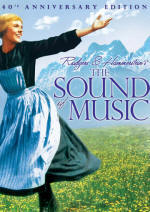 |
In addition to his involvement with the
re-editing of "The Magnificent Ambersons," Bob has been viewed
negatively for not becoming a clone of Welles and, sour grapes-icly, for
his success in an industry that rejected Welles, overlooking the fact
that Bob made more films that a majority of people wanted to see. And
the success of "Music," plus Bob's visibility as Academy president in
the rebellious Sixties, unfairly targeted him as the symbol of the
ossified Hollywood establishment.
Like most of his contemporaries, Bob was never an ostentatious,
flamboyant filmmaker; the closest he ever came to anything like that
being his experimentation with multiple images in "The Andromeda
Strain." He came from what over the last 40 years has been dismissed as
an "old-fashioned" school of film storytelling, one which took a
"subjective" approach, only doing things that might make the audience
aware that they were watching a film when it was germane to the way the
filmmakers had chosen to tell their stories.
A bit of historical perspective is in order here. We tend to think of
pre-Seventies filmmakers as middle-aged or older men, because that's
what they were when the reasonably serious study of American film began
in the Sixties. We Boomers forget that when they began working in the
industry, most of them were also in their Twenties; Bob was just four
years older than Welles. And for them, the period of 1926-29 was
probably what the late-Sixties/early-Seventies were for us, in varying
degrees, for that was when the cinematically innovative films from
France, Germany, and Russia were being imported into the United States.
A comparison of American films made before 1925 with those made after
clearly demonstrates the influence of those foreign films on the
Hollywood product, particularly in a move toward minimizing title cards
and telling the story as visually as possible. Sound interrupted this,
but it was a combination of iconoclastic young directors who had not
been indoctrinated with a literary orientation toward storytelling, like
William Wellman and Lewis Milestone, and older directors sensitive to
the narrative potential of film, like Curtiz, Ford, Lubitsch, and Roland
West, who saw sound as an enrichment and not a means of turning the art
form into elitist critics' ideal of "canned theater," who were the first
to get the visual revolution back on track.
Indeed, it's my postulation that the greatest generations of American
directors were those who SUCCESSFULLY made the transition from silents
to sound and those from the next two decades who, after essentially
apprenticing under them, moved from behind the Moviola, camera, drafting
table, et. al., into the director's chair, the latter group's ranks
including George Stevens, William Wyler, Don Siegel, and, of course, Bob
Wise.
There is something else that these men had in common, something rarely
acknowledged which also affected their filmmaking styles: except for
Wyler, they were all from basically Middle American backgrounds and
therefore instinctively knew how to tailor their films to appeal to
"average Americans." (Wyler, like Curtiz, Hitchcock, Lang, and Billy
Wilder, probably developed these instincts from closely studying Middle
American life.) As New Yorkers have always noted, pre-Seventies Middle
Americans were brought up to show emotional restraint and these
directors' films, especially those from the Forties forward, are rarely
dated by over the top scenery chewing.
A particular example of this is "The Day The Earth Stood Still," one of
the three Fifties science-fiction films whose story scenes do not draw
laughs from contemporary audiences seeing them for the first time, the
other two being "The Thing From Another World" (1951) and "Them!"
(1954). The reason is that all three films are SO DAMNED UNDERPLAYED,
positioning them in an acceptable reality that provides a believable
contrast to the unreality of the unfolding events. In "Day," with the
possible exception of Hugh Marlowe, ALL the humans act the way most
people like to think they'd act in such a situation, whether they really
would in such circumstances or not. (To what extent contemporary life
has been affected by the constant screen depiction of automatic mass
hysteria when something cataclysmic happens really isn't known.)
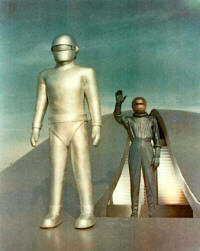 |
|
"The Day the Earth Stood Still" (1951) |
(Sorry, fans of the 1953 "War Of The
Worlds," but I've seen too many post-Sixties audiences rolling in the
aisles at its non-effects scenes to include it in the above.)
This careful, controlled depiction of his characters' emotional states,
often conveyed through body language and adroit editing was always a
characteristic of Bob's films, and this has been a particular indictment
of them from actor/performance-only oriented critics, yet a careful
study of them reveals how that emotional restraint can yield more
emphatic results and stronger emotional impact on a film audience than
big outbursts that may work on the stage or lead to Oscar nominations
but which come off as an embarrassing turnoff to many outside New York
and the L.A. Westside. It was about 40 years before I saw "Somebody Up
There Likes Me" again, and I then realized that it was this restraint in
the performances that made the film work for me as a kid, as the
characters came off as normal people I could relate to, even if they
were blue collar New Yorkers. It also results in a pleasing amiability
in comedies like "Something For The Birds" (1952) and "This Could Be The
Night" (1957).
It is this same restraint which makes the rarely discussed dramatic
scenes in "West Side Story" work so well, the underlying tension in the
encounters between the two gangs and with Simon Oakland's Officer
Schrank. Perhaps the most powerful scene in the film is the one in Doc's
candy store where the fight is being planned and Schrank shows up, which
contrasts so strongly with the scenes between Maria and Tony and really
sets up the poignancy of the ending.
And then there is "The Sand Pebbles" (1966), a film I've found struck a
personal chord with just about everyone who were in their
late-teens/early-Twenties when it was released. At the time it was
acknowledged that the film was allegorically about Viet Nam, and in
Middle America, there was still a lot of potential cannon fodder
blithely accepting the government's claim that what they were doing was
right. "The Sand Pebbles" brought that dilemma to life for a lot of
these kids. In later years, Bob felt that the film was too long, but I
expressed to him my feeling that the length was justified in making the
full weight of the Steve McQueen character's "journey to enlightenment"
impact upon the audience.
At the same time, Bob got interesting atypical performances from certain
actors, such as letting Elisha Cook, Jr. be a lech in "Born To Kill"
(1947), making you feel sympathy for Henry Daniell in "The Body
Snatcher" (1945), albeit briefly, and really infusing "The Set-Up" with
a gallery of realistic blue collar types, including an understated Percy
Helton.
Of course, writing, art direction, cinematography, and post aspects are
all factors in the success of this, but if I had to choose two other
characteristic scenes from Bob's work that I have seen (unfortunately
there are some of his films that I haven't), they would be from "The
Body Snatcher" and "The Sand Pebbles," admittedly similar in subject
matter, but completely different in approach and tone.
 |
The "Body Snatcher" scene is the one in
which Boris Karloff kills Bela Lugosi. Karloff's performance highlights
this scene and while he seems to be over-the-top, when you analyze it,
you realize that it's just far enough to not clash with the rising
suspense and dread. (Bob said Karloff really enjoyed making the film and
you can see that especially in his scenes with Daniell.)
The "Sand Pebbles" scene is the one in which Steve McQueen has to kill
Mako, a key scene for the entire film, which is beautifully set up with
what has gone before, but the way the scene is staged and edited, all
the political and emotional strands of the film come together for the
first time. Bob has described McQueen as one of the most physical actors
he'd ever worked with, one who really knew how to use his body language
and face to make character points far more emphatically than dialog, and
Bob and McQueen make full use of that here, especially in the scene's
topper, where, after the shooting, the wrought up McQueen angrily goes
below alone to the engine room, savagely shovels coal into the boilers,
and then leans on the shovel and starts to sob, the kind of
gut-wrenching moment that really can only be done in a medium like film.
One other point about Bob's work: as a wide screen historian as well as
a fan of the format, when asked, I always refer people to any of Bob's
anamorphic or 65mm films as providing perfect examples of how to use
Wide Screen. I don't know the degree to which this might have been
influenced by Welles, but Bob, like his contemporaries cited above, was
always a fan of deep focus wide angle photography. For him, the sets or
locations were as much a part of his approach to the way he told his
story as the actors, and he often staged dramatic scenes fairly close to
a camera with a wide angle lens so that you were as much aware of the
context in which the scene was occurring as the foreground performances.
(His extreme example of this is "The Captive City" [1952], shot entirely
on location in Carson City, Nevada with a special deep focus lens
developed by Ralph Hoge and Lee Garmes, ASC. The tight spaces in which
they were clearly working in some scenes leads to some often awkward
staging and camera moves and yet, for a film about developing paranoia,
it all seems right.)
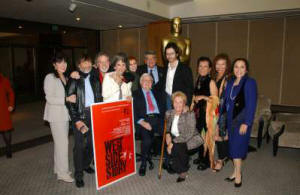 |
|
Wise (center) with cast and crew from "West Side Story" |
Bob naturally took to Wide Screen from
his first CinemaScope picture in 1955 ("Helen Of Troy") and loved the
high image quality of 65mm. He would carry his preference for deep focus
to the point of insisting on using an experimental 30mm Panavision lens
for "The Haunting" (1963) and diopters to keep both something in the
foreground and something in the background in focus. And it's
interesting to note that in at least four of the films he designed for
Bob ("West Side Story," "The Sound Of Music," "The Sand Pebbles," and
"Star!" [1968]), Boris Leven did sets that were essentially VERTICAL for
a horizontal format, something that is particularly effective in "The
Sand Pebbles."
In conclusion, two personal notes: on "Star Trek," whenever I had to
call the set for some reason, I was surprised at how often Bob, not an
assistant director or production assistant, would answer the phone.
And, in the six years before "Star Trek," though I'd encountered Bob
socially enough through functions at USC that he knew my name, out of
the respect for him and the esteem in which I held him, I always called
him "Mr. Wise." About a month into shooting, Todd took me aside and told
me that he was bothered by that, that he felt we'd known each other long
enough that I should be calling him "Bob."
For me, that and his filmography sums up a truly great gentleman.
Rick Mitchell is a film editor, film director, and film historian. He lives in Los Angeles.
© 2005 Rick Mitchell. All rights reserved
IMAGES: © DGA; A.M.P.A.S.; MGM/UA; 20th Century Fox; thesandpebbles.com. All rights reserved

